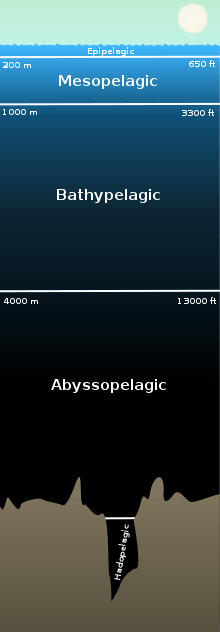Abyssal zone

The abyssal zone or abyssopelagic is a layer of the pelagic zone of the ocean. "Abyss" derives from the Greek word ἄβυσσος, meaning bottomless. At depths of 4,000 to 6,000 metres (13,123 to 19,685 feet), this zone remains in perpetual darkness and never receives daylight. These regions are also characterised by continuous cold and lack of nutrients.The abyssal zone has temperatures around 2 °C to 3 °C (35 °F to 37 °F) through the large majority of its mass.[1] It is the deeper part of the midnight zone which starts in the bathypelagic waters above.[1][2] Its permanent inhabitants (for example, Riftia pachyptila, (the giant tube worm) found near hydrothermal vents in the Pacific Ocean and the giant squid are able to withstand the immense pressures of the ocean depths, up to 76 megapascals (11,000 psi).[2]
The area below the abyssal zone is the sparsely inhabited hadal zone.[3] The zone above is the bathyal zone.[3]
Trenches
The deep trenches or fissures that plunge down thousands of metres below the ocean floor (for example, the midoceanic trenches such as the Mariana Trench in the Pacific) are almost unexplored.[2] Previously, only the bathyscaphe Trieste, the remote control submarine Kaiko and the Nereus have been able to descend to these depths.[4][5] However, as of March 25, 2012 one vehicle, the Deepsea Challenger was able to penetrate to a depth of 10,898.4 metres (35,756 ft).
See also
References
- 1 2 "Deep Sea Biome". Untamed Science. Archived from the original on 31 March 2009. Retrieved 2009-04-27.
- 1 2 3 Nelson, Rob (April 2007). "Abyssal". The Wild Classroom. Archived from the original on 25 March 2009. Retrieved 2009-04-27.
- 1 2 "Abyssal". Dictionary.com. Archived from the original on 18 April 2009. Retrieved 2009-04-27.
- ↑ "History of the Bathyscaph Trieste". Bathyscaphtrieste.com. Retrieved 2009-04-27.
- ↑ "World's deepest-diving submarine missing". USA Today. Gannett Company Inc. 2003-07-02. Retrieved 2009-04-27.